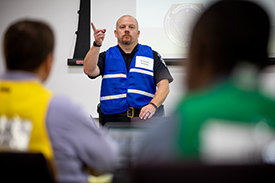What does it take to respond to a pandemic? WSU public safety director says years and years of planning
OGDEN, Utah – As Weber State’s University’s Public Safety Director, Dane LeBlanc has spent the better part of March fielding hundreds of emails, texts and phone calls a day, heading up the university’s COVID-19 taskforce and putting in grueling 18-hour days including the weekends.
It’s LeBlanc’s job to prepare and manage the “what-if” situations – the type of disaster you hope never happens, but have to be ready for.
.jpg) A 20-year veteran of the U.S. Air Force and veteran of the first Gulf War, LeBlanc is no stranger to emergency situations. With Weber State since 1995, he served as the WSU Chief of Police before taking over the Public Safety Director position last year. On a normal work day, LeBlanc might be overseeing any number of issues, from snow days to environmental health and safety. One of his main responsibilities is planning for disaster responses, from pandemics to earthquakes to mass shootings and beyond.
A 20-year veteran of the U.S. Air Force and veteran of the first Gulf War, LeBlanc is no stranger to emergency situations. With Weber State since 1995, he served as the WSU Chief of Police before taking over the Public Safety Director position last year. On a normal work day, LeBlanc might be overseeing any number of issues, from snow days to environmental health and safety. One of his main responsibilities is planning for disaster responses, from pandemics to earthquakes to mass shootings and beyond.
When the global pandemic of COVID-19 forced WSU, along with other universities across the state and nation, to move to online classes in mid-March, LeBlanc was thankful for the years of preparation that had already gone into the response plan.
“I have learned from days in the military, you will respond to the level of training you have been involved with,” LeBlanc said.
When LeBlanc first started hearing word of COVID-19 spreading outside of China in late January and early February, he knew WSU had to quickly prepare itself for the worst-case scenario, and he pulled out the university’s pandemic response plan for an update.
The pandemic response plan had been put together after Swine Flu, a novel influenza, had swept the globe in 2009, and updated again during the Ebola outbreak that started in 2014. LeBlanc coordinates the WSU effort with Mike Davies, WSU’s police captain and emergency manager.
“Every time something happens, we get lessons learned from those things so we can adjust our approach and planning,” Davies said. “It’s been a constant, ongoing process over the last 10 years or more.”
 Having that plan, as well as the support from university officials to execute annual emergency exercises, prepares those who need to be communicating when a crisis actually hits. Over the years, these emergency exercises included multiple agencies from local jurisdictions such as police, fire, paramedics, hospitals, health departments and more coming together, so they know how to work together during a real emergency.
Having that plan, as well as the support from university officials to execute annual emergency exercises, prepares those who need to be communicating when a crisis actually hits. Over the years, these emergency exercises included multiple agencies from local jurisdictions such as police, fire, paramedics, hospitals, health departments and more coming together, so they know how to work together during a real emergency.
“I think it’s amazing how we’ve come together as a community, as a state, and pressed forward,” Davies said. “These are the times that will test us. It’s amazing to see the collaborative effort that everyone is making to mitigate this.”
The hardest part about managing an emergency situation is making decisions quickly, LeBlanc said. But having that plan in place kept things from getting bogged down, allowing major changes like moving classes online to happen quickly.
“We’ve done pretty much everything we can do,” LeBlanc said. “We have eliminated every reason for a student to come to campus.”
LeBlanc said he’s proud of the preparation and collaboration that allowed for Weber State University to respond effectively to one of the largest emergencies to ever face the university.
“People thought I was exercising them to death, but it’s paid off, and I can be proud of that,” LeBlanc said.
However, just because campus is shut down doesn’t mean LeBlanc or Davies can rest. A 5.7 magnitude earthquake that hit the Salt Lake area March 18 was a reminder that disasters are unpredictable, and can’t be expected to come one at a time. There’s also the reality that some of the biggest decisions they’ll be making, like when to allow classes to be held in person again, are yet to come.
“I would just say that it’s important for all of us in our community to make sure we’re focusing on one another’s well-being,” Davies said. “And to make sure we’re always preparing for something else, so it’s not a surprise.”
For photos of COVID-19 task force and a previous training exercise, visit the following links:
wsuucomm.smugmug.com/Marketing-Communications/Covid-19-Response/Covid-19-Task-Force
wsuucomm.smugmug.com/Emergency-Training
Visit weber.edu/wsutoday for more news about Weber State University.
Katie England, web content editor
801-626-7972 • katieengland@weber.edu- Contact:
Allison Barlow Hess, Public Relations director
801-626-7948 • ahess@weber.edu